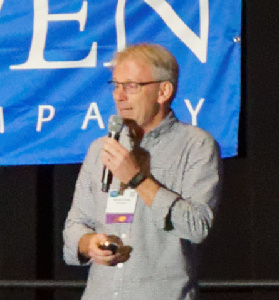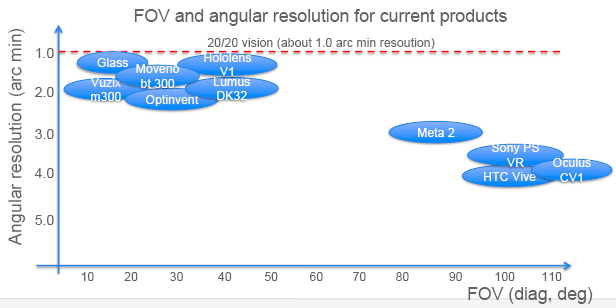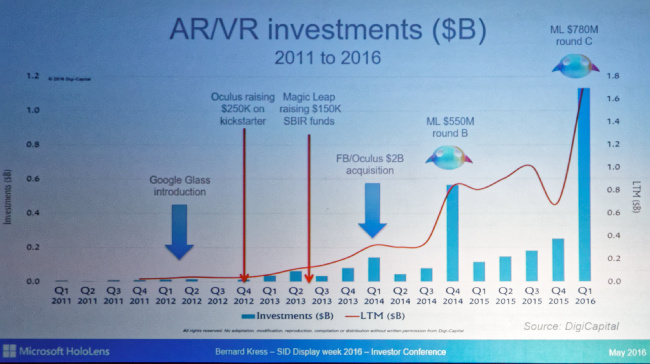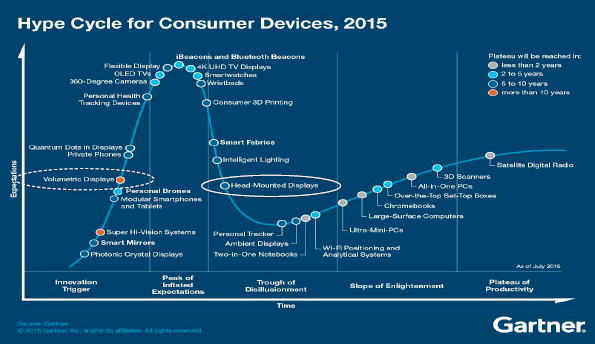 The final talk was by Dr Bernard Kress from the Microsoft Hololens Team. He gave a very, very ‘high bandwidth’ overview of what is happening in VR and AR. There were 175 slides! Before joining Microsoft, he was in the Google Glass team. It took 20 years to go from the brick phone to the smartphone. If the Hololens is the brick phone equivalent, what will the HMD of 20 years look like?
The final talk was by Dr Bernard Kress from the Microsoft Hololens Team. He gave a very, very ‘high bandwidth’ overview of what is happening in VR and AR. There were 175 slides! Before joining Microsoft, he was in the Google Glass team. It took 20 years to go from the brick phone to the smartphone. If the Hololens is the brick phone equivalent, what will the HMD of 20 years look like?
Tablet sales are dropping and Head Mounted Displays are now past the peak of expectation and in the trough of the ‘Gartner Hype cycle’.
Smart glasses are not headsets, they are just an extension of glasses – you will use them because they are glasses and you are only likely to use data 5% to 10% of the time. On the other hand, AR headsets are also the next computing platform. On the other hand, VR glasses are extensions of consoles. Can you merge them is the key question? Technology is developing to try to get this move going. As previous speakers had said, smartglasses have to be fashionable.
For AR you need a 200 deg FOV if the glasses are going to feel natural and normal. On the other hand, for VR you have to paint a field of 100º to 150º. Kress showed a nice chart of FOV and resolution and positioning current shipping products

Making a display with a larger FOV is a challenge. You need a lot of resolution.
Kress said that Microsoft’s Hololens is now shipping and then went at lightning speed through an analysis of all the different approaches to headset design and development.
He then looked at the different displays being used and said that there is no generic type – every technology is being used by somebody, somewhere. Input devices are important parts of the system. There are a lot of challenges ahead (as we are still at the ‘brick phone’ stage).
Kress then went through a long and rapid list of the ways different companies are trying to solve the problems. We show below a table of different technologies being used, currently.

To start with, the first target is to develop untethered headsets and sort out the sensors. Looking at AR/VR investments – there have been rags to riches stories with Oculus starting as late as 2012 and Magic Leap in 2013. He showed a dramatic chart of investments. $1.7 billion in AR in lsat year. There have been no tech IPOs since the end of 2015 but a big amount of investment.

Kress expects that VR ahead will be ahead of AR in market until 2018, then there will be a switch to AR as the more widely used concept.
VR is proving popular and he believes that the New York Times will run a repeat of its previous cardboard promotion in June or July of this year and this kind of promotion is really helpful to develop the market and will lead to broad acceptance of AR and VR.
Hardware is very difficult at the moment – Kress drew an analogy with early CD & DVDs which had incredibly tricky and sophisticated optical components and technology but are now very, very cheap to produce. OEM subsystems need to be standardised and ITRI in Taiwan and Intel are working on standard designs for sensors.
Success will go to those that can standardise the optics – with smaller designs much better as this will allow them to get a lot cheaper. There are lots of new optical technologies in the toolbox and that well mean a lot of new developments over the next 10 to 20 years.
The key point is to match to the human optical system.
Analyst Comment
This was a very interesting talk, although it was hard to keep up in taking notes – I should have turned on some kind of recording equipment! However, Microsoft also brought along a Hololens to try. It’s too big and heavy and expensive (think brick phones!) but I was extremely impressed with the visual quality. I also found that the images shown in the glasses really looked like part of the world outside. They didn’t have the kind of ‘cloud’ look that some of the AR technology that I have seen in the past has. A bit like the Surface Book or Surface Hub, the Hololens will set the performance bar very high and that will really help the market to develop. (BR)


